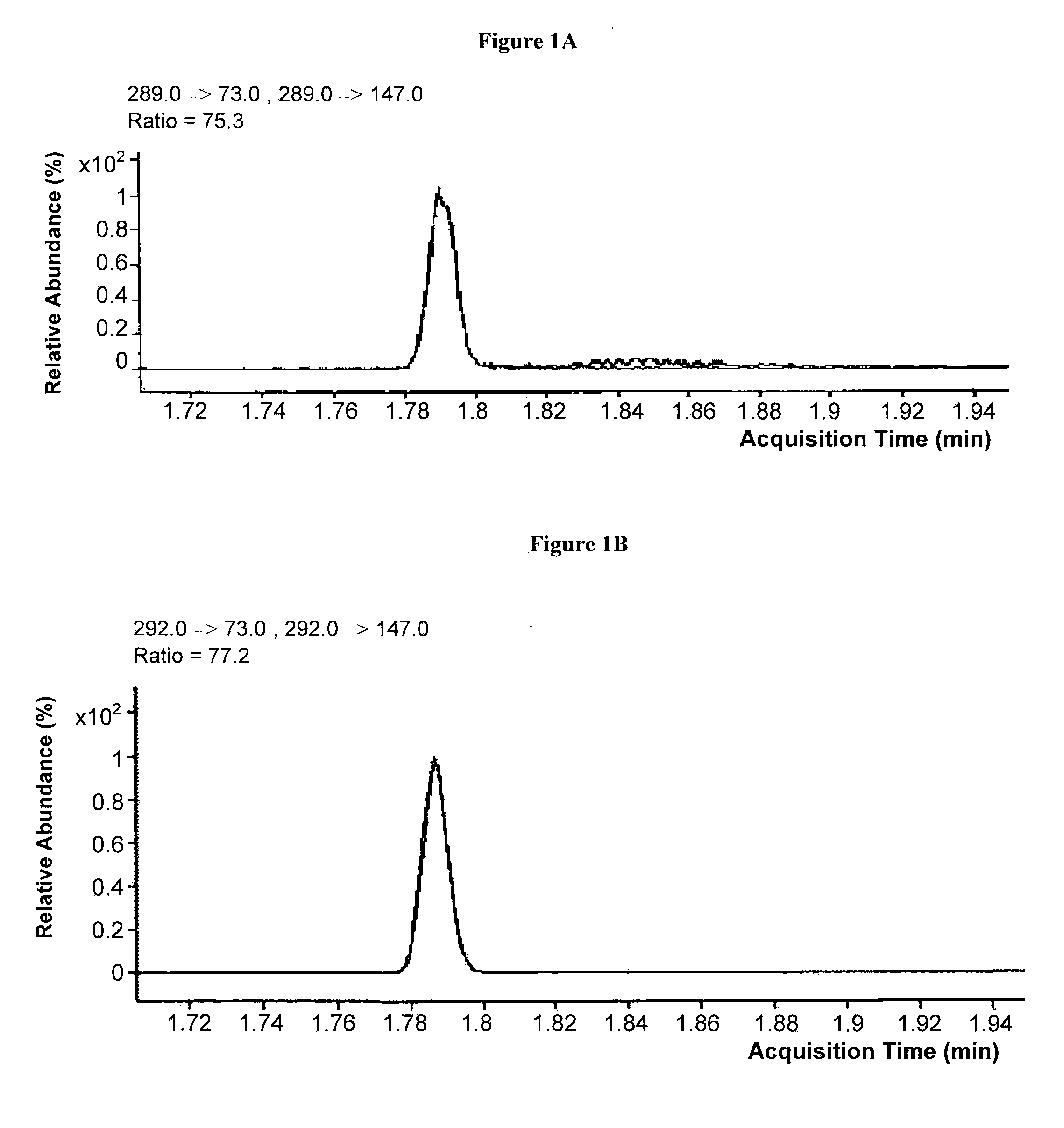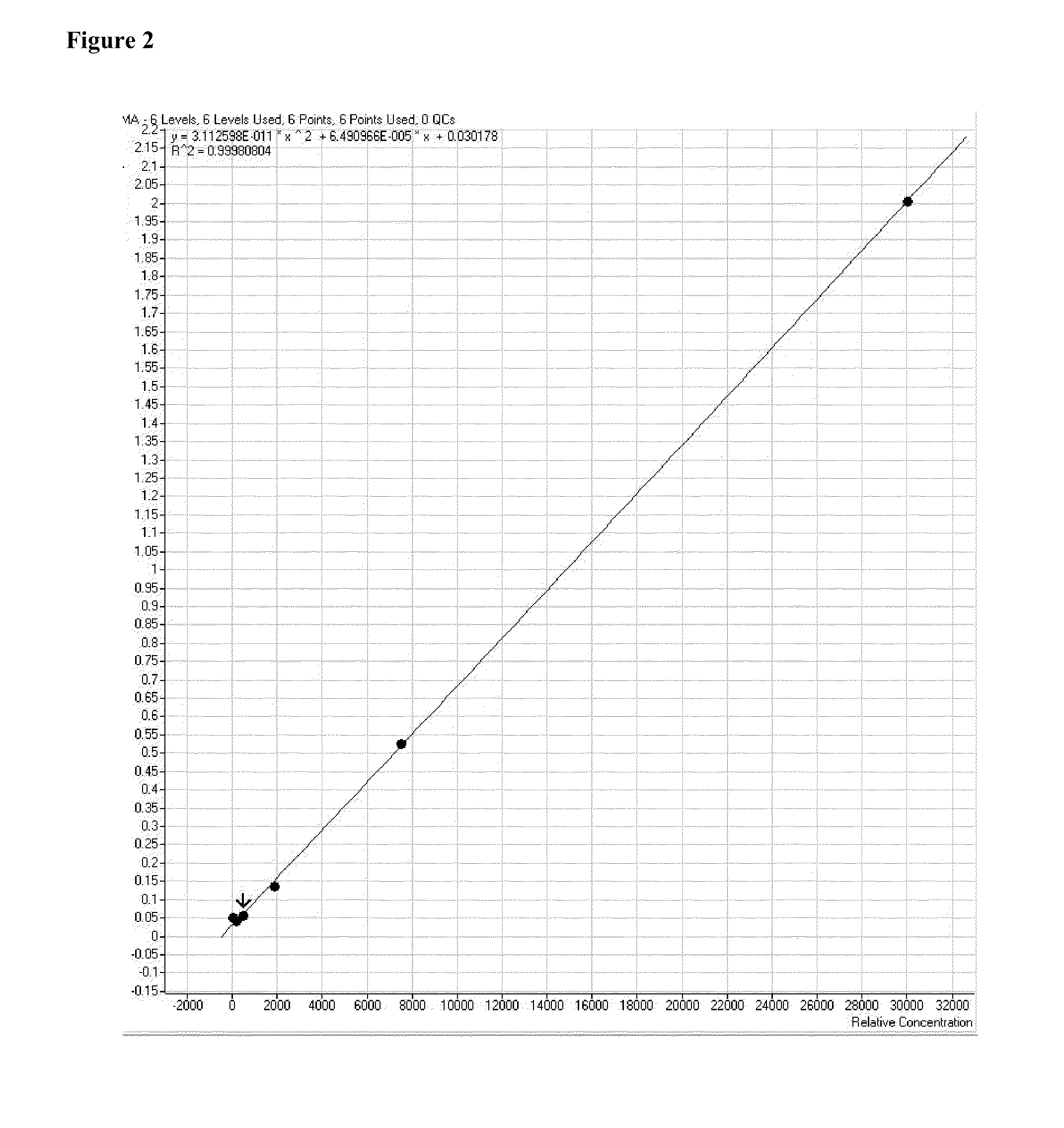Mass spectrometric determination of derivatized methylmalonic acid
a technology of derivatized methylmalonic acid and mass spectrometric measurement, which is applied in the direction of mass spectrometers, separation processes, instruments, etc., can solve the problems of not proceeding to completion, and achieve the effects of improving solvent removal, saving significant time and expense, and being less susceptible to dissociation
- Summary
- Abstract
- Description
- Claims
- Application Information
AI Technical Summary
Benefits of technology
Problems solved by technology
Method used
Image
Examples
example 1
Solid Phase Extraction and TBDMS Derivatization
[0086]The following extraction techniques were conducted on serum samples.
[0087]MMA was extracted from serum samples by solid phase extraction (SPE) on a strong anion exchange (SAX) packed SPE column. Water and 100% methanol were used as wash and elution solvents, respectively. Alternatively, MMA was extracted from serum samples by SPE on a SAX packed SPE column where water and 3 M acetic acid / methanol were used as wash and elution solvents, respectively.
[0088]MMA was then derivatized by adding 150 μl of MTBSTFA with 1% tert-butyl dimethylchlorosilane (TBDMCS) in hexane or pyridine to the collected extracted samples. The resulting mixtures were heated to about 70° C. for 15-20 minutes and chilled at about 4° C. for about 10 minutes. After cooling, the mixtures were transferred to GC / MS vials for analysis.
[0089]Alternatively, MMA from the sample was derivatized by first evaporating the eluted samples to dryness, adding 500 μl of 20% trie...
example 2
Purification of TBDMS-MMA Derivatives with Gas Chromatography
[0090]Purification of TBDMS-MMA derivatives with gas chromatography was conducted with an Agilent 7890A Fast GC equipped with a cyanopropyl methyl siloxane analytical column, such as an Agilent DB-23 cis / trans FAME GC column (DB-23: J&W 122-2361, Agilent Technologies, Wilmington, Del. USA). The GC column was heated to a temperature of about 185° C. and held for about 0.4 minutes. The GC column was then heated further to a temperature of about 300° C. at a rate of about 85° C. / minute. Once the temperature reached about 300° C., the temperature was held at about 300° C. for about 0.6 minutes. Helium was used as the carrier gas at approximately 3 ml / min. Under these conditions, retention time for TBDMS-MMA was about 1.76-1.78 minutes. Succinic acid, a potentially interfering species with a similar mass to MMA, was clearly separated from MMA under this procedure with a retention time of approximately 2.12 minutes.
[0091]Alterna...
example 3
Exemplary Spectra from MS / MS Analysis of TBDMS-MMA
[0096]Tandem mass spectrometric analyses of TBDMS-MMA and TBDMS-MMA-2H3 were conducted by selecting precursor ions with m / z of about 289.0 and 292.0, respectively. The precursor ions were fragmented at collision energies of 3, 5, 8, 10, 12, 15, and 18 V. Exemplary product ion scans generated from these analyses are presented in FIGS. 3A-3G and 4A-4G for TBDMS-MMA and TBDMS-MMA-2H3, respectively.
[0097]Exemplary MRM transitions for the quantitation of TBDMS-MMA include fragmenting a precursor ion with a m / z of about 289.0±0.5 to one or more product ions selected from the group of ions with a m / z of about 189.0±0.5, 147.0±0.5, and 73.0±0.5. As seen in FIGS. 3A-3G and 4A-4G, selection of fragments to monitor for quantitation may depend on the collision energy selected. At a higher collision energy, such as 10 V, fragment ions may include ions with m / z of about 147.0±0.5 and 73.0±0.5, while at lower collision energies, such as about 3 V, ...
PUM
 Login to View More
Login to View More Abstract
Description
Claims
Application Information
 Login to View More
Login to View More - R&D
- Intellectual Property
- Life Sciences
- Materials
- Tech Scout
- Unparalleled Data Quality
- Higher Quality Content
- 60% Fewer Hallucinations
Browse by: Latest US Patents, China's latest patents, Technical Efficacy Thesaurus, Application Domain, Technology Topic, Popular Technical Reports.
© 2025 PatSnap. All rights reserved.Legal|Privacy policy|Modern Slavery Act Transparency Statement|Sitemap|About US| Contact US: help@patsnap.com



